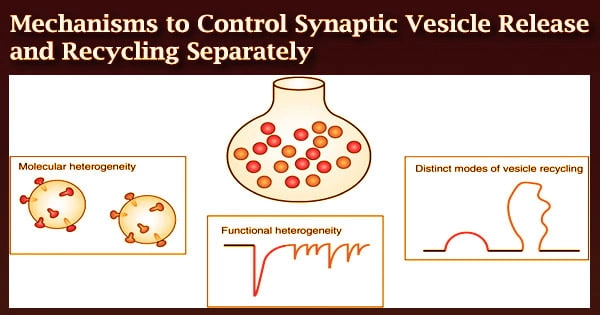Chemical synapses are nerve cells that convey information. Synaptic vesicles fuse with the presynaptic membrane when a presynaptic cell is electrically stimulated, prompting messenger chemicals within the vesicles to be released into the synaptic cleft.
These bind to receptors in the postsynaptic cell, causing an electrical signal to be triggered once more. How information is processed and conveyed in the brain is determined by the temporal and spatial sequencing of incoming inputs. Chemical synapses must recycle synaptic vesicles to make them available for continued signal transmission in order to function in the long run.
Professors Carsten Duch and Martin Heine, as well as their individual research groups at Johannes Gutenberg University Mainz (JGU), are looking into how synaptic vesicle release and recycling are coordinated.
“Exocytosis and endocytosis rates at chemical synapses need to be coordinated to achieve reliable signal transmission in the brain,” the biologists explained.
Duch and Heine, in collaboration with Dr. Ulrich Thomas, group leader at the Leibniz Institute for Neurobiology in Magdeburg, have revealed in a PNAS paper how spatially and temporally separated presynaptic calcium signals regulate synaptic vesicle exocytosis and endocytosis, i.e., their release and recycling.
Co-existence of different types of voltage-gated calcium channels at the presynapse
Incoming electrical impulses are transformed into chemical signals at chemical synapses and sent to the next cell. Calcium ions initially flow into the presynapse, which is the upstream nerve cell that transfers the signal to the postsynaptic cell, via voltage-dependent membrane channels.
Calcium signals are extremely well suited to precisely adapt a variety of vital synaptic functions to differing neuronal activities, but we are only just starting to work out the mechanisms that independently regulate these functions.
Professors Carsten Duch and Martin Heine
This calcium influx is time and location limited, resulting in synaptic vesicle exocytosis from a specific vesicle reservoir. Synaptic vesicle recycling is also regulated by presynaptic calcium signals, but the temporal and spatial requirements are different.
One unanswered question is how presynaptic electrical activity might result in calcium signals at the presynaptic terminal with various temporal and spatial characteristics.
The research team was able to show that the presynapse of the Drosophila melanogaster genetic model organism harbors two different types of voltage-gated calcium channels, Cav2 and Cav1, by combining genetic modifications with electrophysiological and optophysiological measurements at the neuromuscular synapse.
These, on the other hand, were discovered to be spatially separated. When electrical signals come, both types of channels open, but only Cav2 channels in the active zones of the presynapse are required for synaptic vesicle exocytosis. Cav1 channels are located outside active zones and enhance synaptic vesicle endocytosis through activity-dependent calcium influx.
Cav2 knockdown limits synaptic transmission, whereas Cav1 knockdown reduces synaptic vesicle endocytosis, promoting synaptic depression during sustained activity.
This diagram shows how calcium signals mediated by two distinct populations of essentially independent voltage-gated calcium channels regulate two critical activities of the presynapse in response to neuronal activity, namely synaptic vesicle release and recycling.
Functional separation of Cav1 and Cav2 by means of a calcium pump
Because calcium is a very diffusible intracellular messenger, a significant challenge was how calcium signals from distinct channels could be functionally separated at the nanometer scale of the presynaptic terminal.
A membrane-anchored calcium buffer, according to the researchers, separates different important activities of calcium signals through Cav1 and Cav2 channels. Cav2 channels are located 70 to 140 nanometers away from rapidly releasable synaptic vesicles in presynaptic active zones.
During presynaptic electrical activity, Cav2’s unique localisation causes the development of temporally and spatially tightly regulated calcium signals within so-called nano-domains, which are required for temporally precise synaptic transmission.
Cav1 clusters around active zones, allowing calcium influx through both types of channels at the same time, resulting in mixed signals with no discernible delay.
The plasma membrane calcium pump (PMCA), on the other hand, prevents mixed signals of this type. PMCA is found outside active zones, shielding it from Cav1-mediated calcium influx, which controls endocytosis dynamically.
Cav1, Cav2, and PMCA have been found in central synapses in mammalian brains, suggesting that they may form a functional trio for separate activity-dependent regulation of synaptic vesicle exocytosis and endocytosis.
Calcium channels and the regulation of essential synaptic functions
The research groups of Duch and Heine will continue to investigate the interactions of calcium channels and their related compounds at the presynapse in the future. Beyond exocytosis and endocytosis, calcium signals in the presynaptic terminal regulate other important synaptic activities.
These include the control of fixed synaptic transmission strengths, which are restored by compensatory mechanisms following disruption, as well as the regulation of synaptic vesicle migrations between distinct specialized reservoirs.
This homeostatic synaptic plasticity is necessary for the brain to process information reliably. Duch and Heine’s groups are investigating how spatiotemporally separated presynaptic calcium signals independently control exocytosis and endocytosis, vesicle transport between different reservoirs, and synaptic homeostasis as part of a project within Collaborative Research Center 1080 on Molecular and Cellular Mechanisms in Neural Homeostasis.
“Calcium signals are extremely well suited to precisely adapt a variety of vital synaptic functions to differing neuronal activities, but we are only just starting to work out the mechanisms that independently regulate these functions,” Duch and Heine commented on their neurobiology research.





